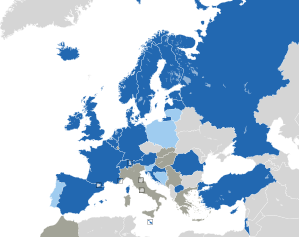Eurovision Song Contest 2000
These countries were replaced by Latvia in its first contest appearance, Finland, Macedonia, Romania and Switzerland which were relegated from the previous year's event, and Russia which returned after a two-year absence.
The 2000 contest was the first to be broadcast over the internet, with a webcast of the live show available in Europe, the United States, Canada and Australia through Microsoft's MSN portals.
The 2000 contest took place in Stockholm, Sweden, following the country's victory at the 1999 edition with the song "Take Me to Your Heaven", performed by Charlotte Nilsson.
The venues chosen following this initial round of discussions were the Scandinavium in Gothenburg, which had previously hosted the 1985 contest; Malmömässan in Malmö; and Globen in Stockholm.
[7][8] Malmö was subsequently eliminated as a potential host city, due to high costs required to complete a suitable arena within the Malmömässan area and which would still have a relatively small audience capacity compared to the other venues on offer.
Of the remaining options, Stockholm and Globen were ultimately chosen by SVT managing director Sam Nilsson [sv] to host the event.
[9] Latvia entered the contest for the first time, and Finland, Macedonia, Romania, Russia, and Switzerland returned after being absent from the previous year's event.
[12] A number of former participating artists also returned to perform as backing vocalists for some of the competing entries: Eyjólfur Kristjánsson [is], having previously represented Iceland in 1991 alongside Stefán Hilmarsson [is], returned to support the Icelandic duo August and Telma as a backing singer;[13] Albano Carrisi, who twice represented Italy in 1976 and 1985 with Romina Power as Al Bano and Romina Power, supported Switzerland's Jane Bogaert on stage;[14] and Gabriel Forss, a member of the group Blond that represented Sweden in 1997, was a backing singer for Malta's Claudette Pace in this year's event.
In cases where the average was identical between two or more countries, the total number of points scored in the most recent contest determined the final order.
[9] Bosnia and Herzegovina, Lithuania, Poland, Portugal and Slovenia were therefore excluded from participating in the 2000 contest, to make way for the return of Finland, Macedonia, Romania, Russia and Switzerland, and debuting country Latvia.
[5][29] On behalf of the contest organisers, the European Broadcasting Union (EBU), the event was overseen by Christine Marchal-Ortiz as scrutineer.
[6][34] A compilation album featuring all 24 competing entries was released within Europe ahead of the contest, through the German record labels Ariola and BMG.
This submission was required to include a sound recording of the entry and backing track for use during the contest, a video presentation of the song on stage being performed by the artists, and the text of the song lyrics in its original language and translations in French and English for distribution to the participating broadcasters, their commentators and juries.
[9][37] Each participating country was required to use televoting to determine their points, with viewers able to register their vote by telephone for a total of five minutes following the performance of the last competing entry.
[9] Countries which were unable to hold a televote due to technological limitations could be granted an exception and their points would then be determined by a jury.
Each jury was composed of eight individuals, which was required to be split evenly between members of the public and music professionals, comprised additionally of an equal number of men and women, and below and above 30 years of age.
The votes of each member were collected immediately following the country's performance and then tallied by the non-voting jury chairperson to determine the points to be awarded.
[29][34] Listed below by order of performance are the locations featured in each postcard as well as the concept for the respective country represented:[29] The contest took place on 13 May 2000 at 21:00 (CEST) and lasted 3 hours and 2 minutes.
[2][9][29] The show began with a video montage, comprising various scenes of contemporary Sweden overlayed with the shadow of a human mouth, representing the contest logo, reciting the names of the 24 participating countries in English in the order in which they would perform.
The music video for the song, released the month before the contest, featured same-sex kissing amongst the band members, singing into cucumbers, and other suggestive scenes with phallic imagery, which caused consternation with Israeli religious leaders and right-wing groups.
[9] Broadcasters were able to send commentators to provide coverage of the contest in their own native language and to relay information about the artists and songs to their viewers.


